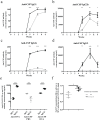A Rapid-Response Humoral Vaccine Platform Exploiting Pre-Existing Non-Cognate Populations of Anti-Vaccine or Anti-Viral CD4+ T Helper Cells to Confirm B Cell Activation
- PMID: 27861512
- PMCID: PMC5115735
- DOI: 10.1371/journal.pone.0166383
A Rapid-Response Humoral Vaccine Platform Exploiting Pre-Existing Non-Cognate Populations of Anti-Vaccine or Anti-Viral CD4+ T Helper Cells to Confirm B Cell Activation
Abstract
The need for CD4+ T cell responses to arise de novo following vaccination can limit the speed of B cell responses. Populations of pre-existing vaccine-induced or anti-viral CD4+ T cells recognising distinct antigens could be exploited to overcome this limitation. We hypothesise that liposomal vaccine particles encapsulating epitopes that are recognised, after processing and B cell MHCII presentation, by pre-existing CD4+ T cells will exploit this pre-existing T cell help and result in improved antibody responses to distinct target antigens displayed on the particle surface. Liposomal vaccine particles were engineered to display the malaria circumsporozoite (CSP) antigen on their surface, with helper CD4+ epitopes from distinct vaccine or viral antigens contained within the particle core, ensuring the B cell response is raised but focused against CSP. In vivo vaccination studies were then conducted in C57Bl/6 mice as models of either vaccine-induced pre-existing CD4+ T cell immunity (using ovalbumin-OVA) or virus-induced pre-existing CD4+ T cell immunity (murine cytomegalovirus-MCMV). Following the establishment of pre-existing by vaccination (OVA in the adjuvant TiterMax® Gold) or infection with MCMV, mice were administered CSP-coated liposomal vaccines containing the relevant OVA or MCMV core CD4+ T cell epitopes. In mice with pre-existing anti-OVA CD4+ T cell immunity, these vaccine particles elicited rapid, high-titre, isotype-switched CSP-specific antibody responses-consistent with the involvement of anti-OVA T helper cells in confirming activation of anti-CSP B cells. Responses were further improved by entrapping TLR9 agonists, combining humoral vaccination signals 'one', 'two' and 'three' within one particle. Herpes viruses can establish chronic infection and elicit significant, persistent cellular immune responses. We then demonstrate that this principle can be extended to re-purpose pre-existing anti-MCMV immunity to enhance anti-CSP vaccine responses-the first description of a strategy to specifically exploit anti-cytomegalovirus immunity to augment vaccination against a target antigen.
Conflict of interest statement
The authors have declared that no competing interests exist.
Figures





Similar articles
-
Viral Persistence Induces Antibody Inflation without Altering Antibody Avidity.J Virol. 2016 Apr 14;90(9):4402-4411. doi: 10.1128/JVI.03177-15. Print 2016 May. J Virol. 2016. PMID: 26889035 Free PMC article.
-
mTOR Promotes Antiviral Humoral Immunity by Differentially Regulating CD4 Helper T Cell and B Cell Responses.J Virol. 2017 Jan 31;91(4):e01653-16. doi: 10.1128/JVI.01653-16. Print 2017 Feb 15. J Virol. 2017. PMID: 27974559 Free PMC article.
-
Adenoviral vaccine induction of CD8+ T cell memory inflation: Impact of co-infection and infection order.PLoS Pathog. 2017 Dec 27;13(12):e1006782. doi: 10.1371/journal.ppat.1006782. eCollection 2017 Dec. PLoS Pathog. 2017. PMID: 29281733 Free PMC article.
-
The role of B cell antigen presentation in the initiation of CD4+ T cell response.Immunol Rev. 2020 Jul;296(1):24-35. doi: 10.1111/imr.12859. Epub 2020 Apr 18. Immunol Rev. 2020. PMID: 32304104 Review.
-
Generation of memory B cells and their reactivation.Immunol Rev. 2018 May;283(1):138-149. doi: 10.1111/imr.12640. Immunol Rev. 2018. PMID: 29664566 Review.
Cited by
-
Pre-existing CD4 T cell help boosts antibody responses but has limited impact on germinal center, antigen-specific B cell frequencies after influenza infection.Front Immunol. 2023 Aug 30;14:1243164. doi: 10.3389/fimmu.2023.1243164. eCollection 2023. Front Immunol. 2023. PMID: 37711622 Free PMC article.
-
The interplay between environmental factors, vector competence and vaccine immunodynamics as possible explanation of the 2019 yellow fever re-emergence in Nigeria.New Microbes New Infect. 2021 Feb 27;41:100858. doi: 10.1016/j.nmni.2021.100858. eCollection 2021 May. New Microbes New Infect. 2021. PMID: 33912348 Free PMC article. Review.
-
Electrostatically Driven Encapsulation of Hydrophilic, Non-Conformational Peptide Epitopes into Liposomes.Pharmaceutics. 2019 Nov 18;11(11):619. doi: 10.3390/pharmaceutics11110619. Pharmaceutics. 2019. PMID: 31752070 Free PMC article.
-
A Minimally Replicative Vaccine Protects Vaccinated Piglets Against Challenge With the Porcine Epidemic Diarrhea Virus.Front Vet Sci. 2019 Oct 22;6:347. doi: 10.3389/fvets.2019.00347. eCollection 2019. Front Vet Sci. 2019. PMID: 31696121 Free PMC article.
-
Novel approaches for the design, delivery and administration of vaccine technologies.Clin Exp Immunol. 2019 May;196(2):189-204. doi: 10.1111/cei.13287. Epub 2019 Apr 8. Clin Exp Immunol. 2019. PMID: 30963549 Free PMC article. Review.
References
-
- Plotkin S.A. (2005) Vaccines: past, present and future. Nature Medicine, 11, S5–11. Available: https://doi.org/10.1038/nm1209 - DOI - PMC - PubMed
-
- Lambert P.-H., Liu M. and Siegrist C.-A. (2005) Can successful vaccines teach us how to induce efficient protective immune responses? Nature Medicine, 11, S54–62. Available: https://doi.org/10.1038/nm1216 - DOI - PubMed
-
- Parker D.C. (1993) T cell-dependent B cell activation. Annual Review of Immunology, 11, 331–60. Available: https://doi.org/10.1146/annurev.iy.11.040193.001555 - DOI - PubMed
-
- Ruprecht C.R. and Lanzavecchia A. (2006) Toll-like receptor stimulation as a third signal required for activation of human naive B cells. European Journal of Immunology, 36, 810–6. Available: https://doi.org/10.1002/eji.200535744 - DOI - PubMed
-
- Okada T., Miller M.J., Parker I., Krummel M.F., Neighbors M., Hartley S.B. et al. (2005) Antigen-engaged B cells undergo chemotaxis toward the T zone and form motile conjugates with helper T cells. PLoS Biology, 3, 1047–61. Available: https://doi.org/10.1371/journal.pbio.0030150 - DOI - PMC - PubMed
MeSH terms
Substances
Grants and funding
LinkOut - more resources
Full Text Sources
Other Literature Sources
Medical
Research Materials

